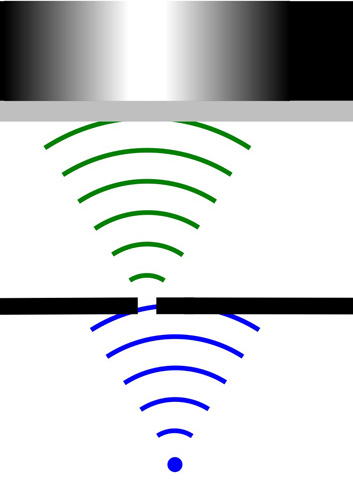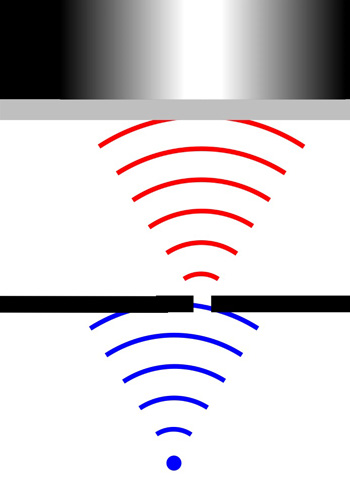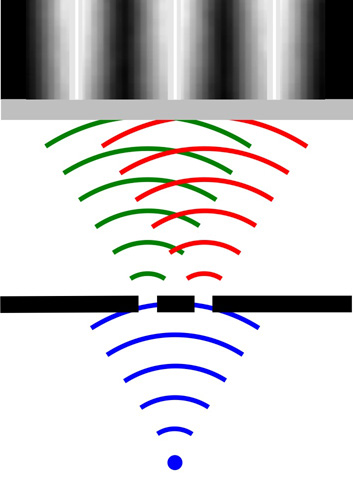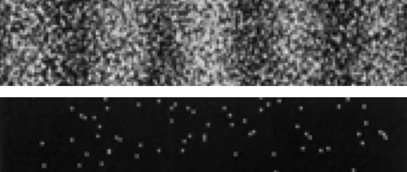|
The most important experiment of quantum mechanics, and perhaps all of physics, is the two-slit experiment. It proves particle-wave duality, the fundamental principle of quantum mechanics — the principle from which all of quantum mechanics develops.
Nobel Laureate Richard Feynman said all the “peculiarities” of quantum mechanics are encapsulated in the two-slit experiment.
To paraphrase the inscription on the Gates of Hell in Dante’s Inferno:
“Abandon all hope,
ye quantum students who master not the Two-Slits.”
Let’s begin exploring the two-slit experiment by examining wave interference.
 At
the bottom of this image, a source emits light waves whose crests are
shown as blue arcs — for clarity the wavelength is greatly exaggerated.
The light waves move upward and hit a black barrier with one small slit
slightly left of center. At
the bottom of this image, a source emits light waves whose crests are
shown as blue arcs — for clarity the wavelength is greatly exaggerated.
The light waves move upward and hit a black barrier with one small slit
slightly left of center.
Some
light passes through the slit; its frequency does not change, but for
clarity, its crests are shown in green. That light finally hits a gray
strip of film. At the top, the black rectangle containing shades of gray
depicts the film after being exposed. Black film indicates zero
exposure. The film is whitest (most intensely exposed) at the green
wave’s center, in line with the single slit, and gradually darkens on
both sides.

The
next image shows the same action, but with the slit now slightly right
of center. The light crests here are shown in red, although all light
waves in these images have exactly the same frequency. Again, the film
exposure is most intense in line with the slit, and gradually darkens on
both sides.

Now, let’s open both slits, as shown in the next image. Here, the green and red waves interfere.
Since
the green and red waves have a common source and traverse identical
geometries up to the barrier, they crest and trough at the same time,
with the same amplitude, at the barrier — we say these waves are coherent. [Coherent waves have the same frequency, and crest and trough synchronously.]
The
green and red waves have equal path lengths to the middle of the film,
hence both waves crest and trough at the same time there as well — the
waves are in-phase and interfere constructively.
Their sum is simply a wave with twice the amplitude, and therefore four
times the intensity (energy). This creates a bright white stripe at the
film’s center.
As
one gradually moves left from the film’s center, the green wave’s path
length from the barrier decreases, while the red wave’s path length
increases. The green and red waves no longer crest and trough at the
same time, diminishing their sum and the film’s exposure — the film
gradually darkens.
At
some distance L left of center, the green path length becomes one-half
wavelength shorter than the red path length. Here, one wave crests when
the other troughs — the green and red waves are out-of-phase and interfere destructively; their sum is exactly zero at all times, creating a black stripe on the film.
At
about 2L left of center, the green and red path lengths differ by
exactly one wavelength, so the waves crest and trough at the same time
and produce another white stripe.
The alternating pattern of white and black stripes — called interference fringes — continues across the film, and symmetrically on both sides of center.
The
black fringes are particularly remarkable. These are places on the film
that green waves would expose, if only the left slit were open, and
that red waves would expose, if only the right slit were open, but no
light reaches these places when both slits are open. Light reaches these
places when there is one way to get there, but does not when there are
two ways to get there!
Waves from one slit prevent waves from the other slit reaching the black fringes.
This
behavior is a hallmark of waves. No self-respecting classical particle
would ever act so strangely — if two pitchers simultaneously throw
baseballs toward home plate, it is inconceivable that zero baseballs
arrive.
Yet…if we throw electrons, we get a big surprise.

These
two images result from replacing the light source with an electron
source. The lower image results from the exposure of 200 electrons. The
individual small dots prove electrons act as particles — ever seen an
ocean wave hit a single grain of sand?
The
upper image results from the exposure of 140,000 electrons. It clearly
shows interference fringes, proving electrons also act as waves.
These
images, by Dr. Tonomura of Hitachi, were exposed at such low-intensity
that only one electron at a time traversed the equipment. This forces us
to accept the startling conclusion that each electron traversed both slits simultaneously, creating two interfering electron-waves that hit the detector at a single point, in a particle-like manner.
These images prove electrons act as both classical particles and classical waves — two things classical physics says are entirely distinct and incompatible.
Conversely, the quantum mechanical principle of particle-wave duality says everything in nature has both particle and waves properties.
Only particle-wave duality can explain Tonomura’s images.
The interference seen above occurs only if the electrons are undisturbed from source to detector.
A comprehensive analysis of the two-slit experiment, with all the math, is in my print books Quantum Mechanics and Feynman Simplified part3 and my ebook Feynman Simplified 3A.

Best Regards,
Robert
December, 2019
Note: Previous newsletters can be found on my website.
|